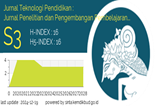The Use of Capcut Application in Improving Students’ Creativity in Social Studies Learning at Junior High School
Abstract
Keywords
Full Text:
PDFReferences
Abdulkarim, A., Ratmaningsih, N., & Anggraini, D. N. (2018). Developing civicpedia as a civic education E-learning media to improve students’ information literacy. Journal of Social Studies Education Research, 9(3), 45–61. https://doi.org/10.17499/jsser.32139
Akbar, R. R. A., & Komarudin, K. (2018). Pengembangan Video Pembelajaran Matematika Berbantuan Media Sosial Instagram sebagai Alternatif Pembelajaran. Desimal: Jurnal Matematika, 1(2), 209. https://doi.org/10.24042/djm.v1i2.2343
Anggraeni, D., Festiyed, & Asrizal. (2019). Meta Analisis Pengaruh Model Pembelajaran Problem Based Learning Terhadap Kemampuan Berpikir Kritis. Pillar of Physics Education, 12(4), 881–888. https://doi.org/10.19109/bioilmi.v8i1.12882
Asrori, & Rusman. (2020). Classroom Action Research: Pengembangan Kompetensi Guru. Purwokerto: CV. Pena Persada.
Dietrich, A. (2018). Types of creativity. Psychonomic Bulletin and Review, 26(1), 1–12. https://doi.org/10.3758/s13423-018-1517-7
Effendi, R. (2018). Perspektif Dan Tujuan Pendidikan IPS. Universitas Pendidikan Indonesia, 1–41.
GCI. (2015). Global Creativity Index. [Online]. Diakses dari http://chartsbin.com/view/41109
Guilford, J. . (1967). Creativity Research: Past, Present and Future. University Southern California.
Mahnun, N. (2012). Media Pembelajaran (Kajian terhadap Langkah-Langkah Pemilihan Media dan Implementasinya dalam Pembelajaran). Jurnal Pemikiran Islam, 37(1), 27–35. https://doi.org/10.4236/ce.2020.113020
Makmur, A. (2015). Efektivitas Penggunaan Metode Base Method dalam Meningkatkan Kreativitas dan Motivasi Belajar Matematika Siswa SMPN 10 Padangsidimpuan. Jurnal EduTech, 1(1), 1–15.
Mayr, E. (1981). The Growth of Biological Thought: Diversity, Evolution and Inheritance. Cambridge: Harvard University Press.
Mutiani, M., Supriatna, N., Abbas, E. W., Rini, T. P. W., & Subiyakto, B. (2021). Technological, Pedagogical, Content Knowledge (TPACK): A Discursions in Learning Innovation on Social Studies. The Innovation of Social Studies Journal, 2(2), 135. https://doi.org/10.20527/iis.v2i2.3073
Republika. (2023). Aplikasi Edit Video dengan Hasil Menakjubkan. [Online]. Diakses dari https://mlipir.republika.co.id/posts/199511/link-download-Capcut-aplikasi-edit-video-mudah-dengan-hasil-menakjubkan
Rusman, Riyana, C., & Kurniawan, D. (2012). Pembelajaran Berbasis Teknologi Informasi dan Komunikasi: Mengembangkan Profesionalitas Guru. Rajawali Pers.
Safitri, D., & Jamilah, F. (2021). Pengembangan Media Video Pembelajaran Menganalisis Teks Prosedur Menggunakan Aplikasi Capcut Pada Kelas XI MAN 2 Yogyakarta. Universitas PGRI Yogyakarta.
Sapriya. (2011). Pendidikan IPS Konsep dan Pembelajaran. Bandung: Remaja Rosdakarya.
Saripudin, D., Ratmaningsih, N., & Anggraini, D. N. (2023). The Development of Podcast Based Learning Media on Social Studies to Improve Students’ Digital Literacy. New Educational Review, 71, 35–49. https://doi.org/10.15804/tner.23.71.1.03
Septikasari, R., & Frasandy, N. (2020). Keterampilan 4C Abad 21 Dalam Pembelajaran Pendidikan Dasar. Jurnal Tarbiyah Al Awlad, 8, 107–117. https://doi.org/10.1016/j.jacc.2020.04.015
Supriatna, N., & Maulidah, N. (2020). Pedagogi Kreatif Menumbuhkan Kreativitas dalam Pembelajaran Sejarah dan IPS. Remaja Rosdakarya.
Suyamto, J., Masykuri, M., & Sarwanto, S. (2020). Analisis Kemampuan Tpack (Technolgical, Pedagogical, and Content, Knowledge) Guru Biologi Sma Dalam Menyusun Perangkat Pembelajaran Materi Sistem Peredaran Darah. INKUIRI: Jurnal Pendidikan IPA, 9(1), 44–53. https://doi.org/10.20961/inkuiri.v9i1.41381
Tan, O.S. (2009). Problem-Based Learning and Creativity. Singapore: Congage Learning.
Trilling, B., & Fadel, C. (2009). 21st Century Skills Learning for Life in Our Times. San Francisco: Jossey-Bass A Wiley Imprint.
DOI: https://doi.org/10.33394/jtp.v8i4.9043
Refbacks
- There are currently no refbacks.
Copyright (c) 2023 Dara Priandini, Nana Supriatna, Diana Noor Anggraini

This work is licensed under a Creative Commons Attribution-ShareAlike 4.0 International License.
This Journal has been Indexed by:
Jurnal Teknologi Pendidikan
ISSN: 2656-1417 (Online)
ISSN: 2503-0620 (Print)
Published by Program Studi Teknologi Pendidikan, FIPP
Universitas Pendidikan Mandalika
Email: [email protected]

This work is licensed under a Creative Commons Attribution-ShareAlike 4.0 International License.















.png)






